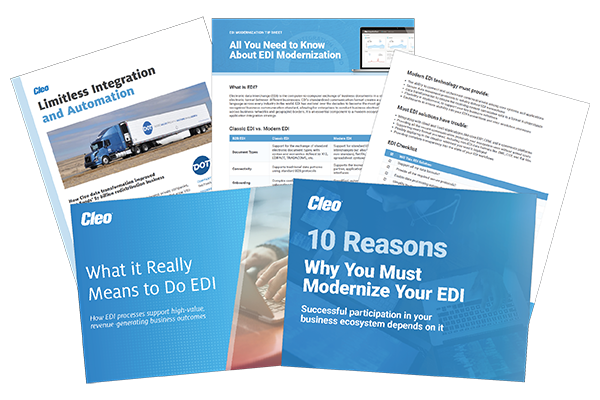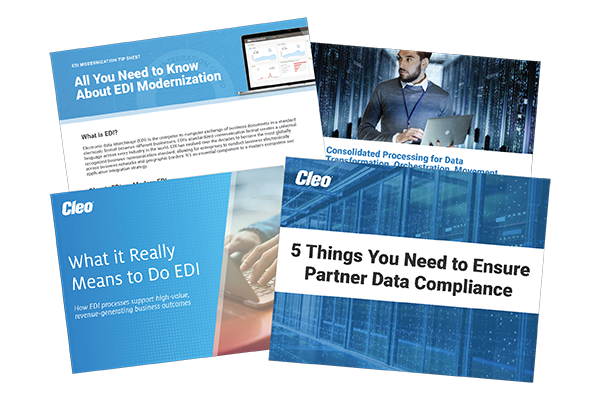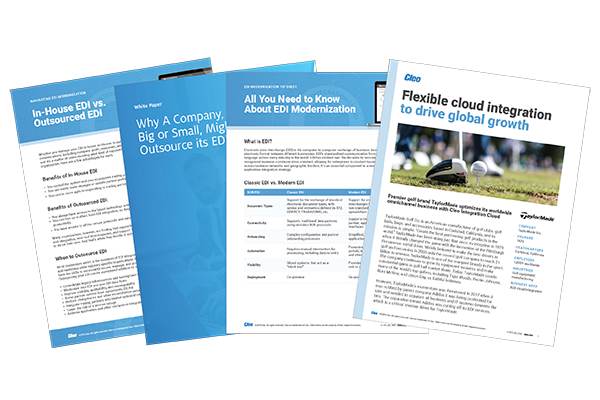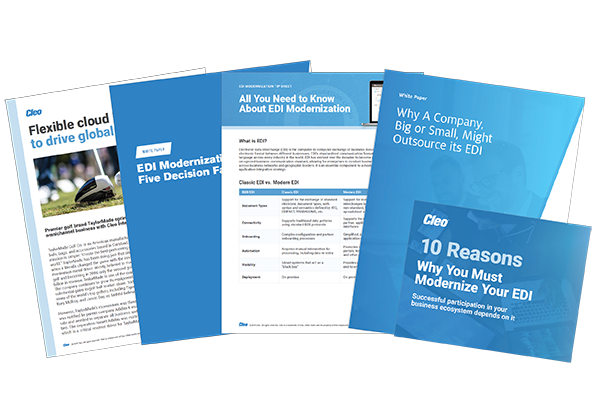Get Your EDI Success Kit
We hear it all the time: “WE NEED AN EDI STRATEGY!” But depending on whom you talk to, an EDI strategy can mean a lot of different things. EDI is too critical to the success of an organization to have any confusion as to its business importance and how such critical processes are being achieved. It’s essential for each stakeholder, then, to comprehend what’s at stake and to be speaking the same language on your core EDI strategy.
To help you understand the direction your business is headed and what you need to get there, we’ve compiled a list of assets to inform your EDI journey, whether it’s a simple technology assessment or a path toward a fully outsourced EDI solution. Each EDI Success Kit outlines common EDI challenges and provides guidance for your organization on how to improve EDI processes, fill in any capability gaps, and enable end-to-end automation.
Gain access to all of these free EDI success kits:
| 1. B2B + EDI Orchestration and Optimization | 4. EDI Compliance |
| 2. Current EDI Software and Infrastructure Evaluation | 5. EDI Outsourcing |
| 3. EDI Automation | 6. EDI Modernization |
We will email you an ungated copy to reuse and share with your colleagues. Don't forget to check your junk folder.
B2B + EDI Orchestration and Optimization
Doing EDI today also means supporting the non-EDI formats, such as XML, CSV, and flat files, that your partners are using. Learn how to support and orchestrate EDI, XML, and API-based B2B interactions using a single enhanced EDI solution and improve partner onboarding, optimize data workflows, and enable your ecosystem.
What's Included:
- Data Sheet: Big EDI vs. little edi
- Data Sheet: The Difficulty of B2B + EDI
- White Paper: 10 Reasons Why You Must Modernize Your EDI

Current EDI Software and Infrastructure Evaluation
What's the current state of your EDI solutions? Are you satisfied with your partner onboarding processes? How much custom-code and ad-hoc integration is involved? Are you thinking about moving to the cloud? If you're having trouble executing all the B2B data exchange processes your business requires, it might be time to re-evaluate your current EDI software and infrastructure.
What's Included:
- E-Book: What It Really Means to Do EDI
- EDI Modernization Checklist
- White Paper: 10 Reasons Why You Must Modernize Your EDI

EDI Automation
Manually re-entering faxed or emailed purchase orders, invoices, and other EDI documents often means wasted time and money and countless data errors. Here's how organizations can eliminate time-consuming manual processes and customization, accelerate order-to-cash and procure-to-pay workflows, and speed your time to value.
What's Included:
- Case Study: How Dot Foods Eliminated Manual EDI, Non-EDI Processes
- E-Book: What It Really Means to Do EDI
- EDI Modernization Checklist
- White Paper: 10 Reasons Why You Must Modernize Your EDI

EDI Compliance
Many businesses and industries today demand EDI formats and processes to interact with them. Your business will be EDI-compliant when it adheres to widely accepted EDI standards and can send and receive electronic documents in the format your partners require. Let's get your EDI compliance in order today.
What's Included:
- Data Sheet: 5 Things You Need to Ensure Partner Data Compliance
- E-Book: What It Really Means to Do EDI
- EDI Modernization Checklist

EDI Outsourcing
Do you really need to be managing your EDI integration processes today? Finding and keeping people with integration skills is challenging, and the resources who’ve managed legacy EDI will eventually move on and leave. Learn how outsourcing EDI will take the EDI burden off your IT teams and help you refocus on core business initiatives.
What's Included:
- Case Study: How TaylorMade Outsourced EDI to Optimize Its Worldwide Omnichannel Business
- Data Sheet: In-House vs. Outsourced EDI
- EDI Modernization Checklist
- White Paper: Why a Company, Big or Small, Might Outsource Its EDI

EDI Modernization
EDI revolutionized B2B data exchange processes and standardized communications for a number of industries, but many systems are dated, to put it gently. More organizations in the age of the cloud and digital transformation are ditching legacy and homegrown systems and modernizing their solutions to support all the EDI and non-EDI data patterns that the current business landscape demands.
What's Included:
- Case Study: How Cloud EDI Integration Transformed TaylorMade Golf's Global Business
- EDI Modernization Checklist
- White Paper: 10 Reasons Why You Must Modernize Your EDI
- White Paper: EDI Modernization: Five Decision Factors
- White Paper: Why a Company, Big or Small, Might Outsource Its EDI

Frequently Asked Questions
What are the benefits of EDI?
EDI has been integral to global business commerce for decades, and it's because it provides numerous benefits for business-to-business communications. EDI is a standardized data format and business language that speeds up the onboarding of customers and trading partners. But EDI also delivers cost savings, faster order-to-cash cycles, improved data quality and accuracy, greater process automation, and increased security when paired with advanced communication protocols. Ultimately, EDI vastly improves business efficiency and agility and helps to deliver greater economies of scale.
How do I choose the right EDI solution?
So much of your bottom line depends on revenue-generating EDI processes, and it's critical to choose the right EDI solution. Which solution you select all depends on your current and future business needs. But how will you know what kind of requirements your business will have down the road? You don't, and that's why it's important to evaluate not only a robust EDI solution that supports all the protocols and even non-EDI formats your ecosystem demands now, but a vendor who will invest in maintaining the technology and your business's success. Your EDI vendor and solution should be a strategic partnership. That partner will take the time to understand your business and pain points and will continue to innovate solutions for whatever's on the EDI and B2B horizon.
Which type of EDI deployment - on-premise, cloud, or fully managed - is right for my business?
The question of whether to leverage an on-premise, cloud (as-a-service), or fully managed model can be answered by how much EDI processing you want or are able to handle. On-premise or private cloud deployments put the onus on your internal resources to manage the EDI technology and processing in-house. An as-a-service option entails leveraging a solution in the cloud in more of a self-service model, where your IT teams manage the EDI processes in a hosted system but not necessarily the underlying technology. In a fully-managed EDI solution, a team of experts will comprehensively manage and maintain the solution for you, taking any day-to-day EDI responsibilities off your plate. For most companies, however, EDI is not a core business competency and is a process that takes a very specialized skill set, and more and more are discovering the value of a managed EDI service.
Have additional questions?
Request a meeting today and we can better understand your business and EDI needs.
Understand the true value of EDI integration in 2 minutes
- Handle evolving integration requirements
- Gain the power of any-to-any transformation
- Tackle EDI and non-EDI demands
